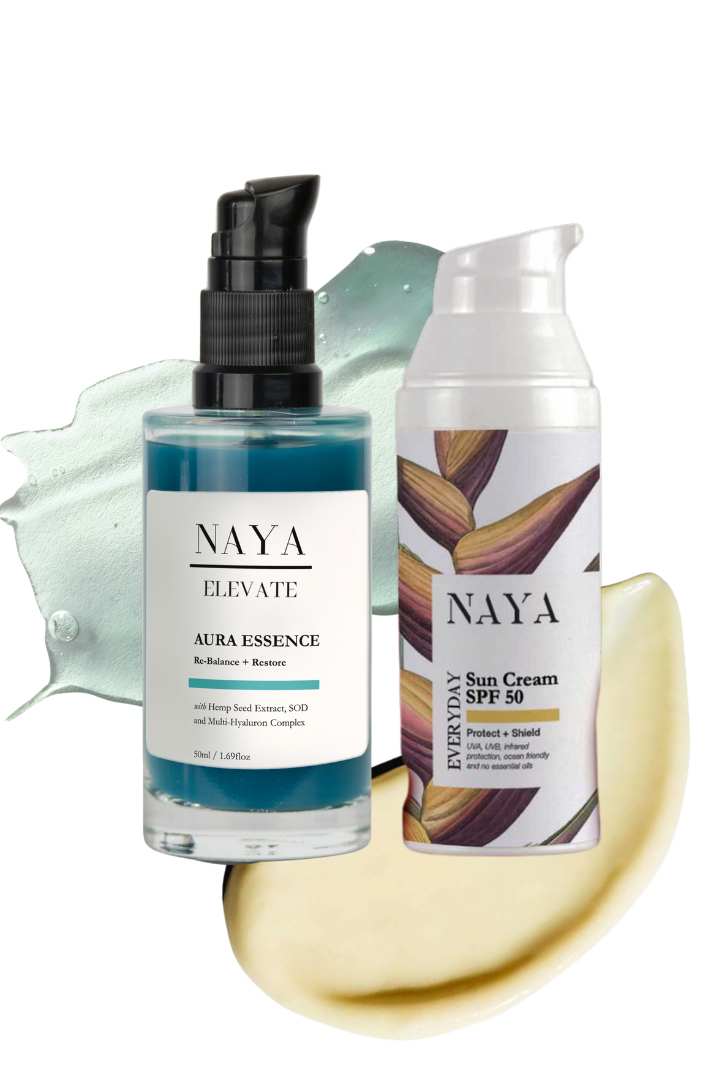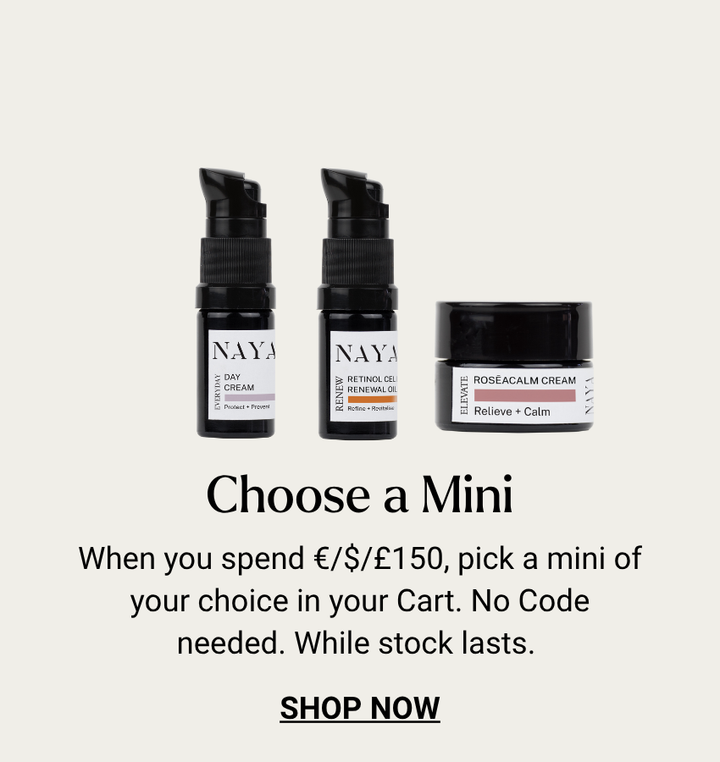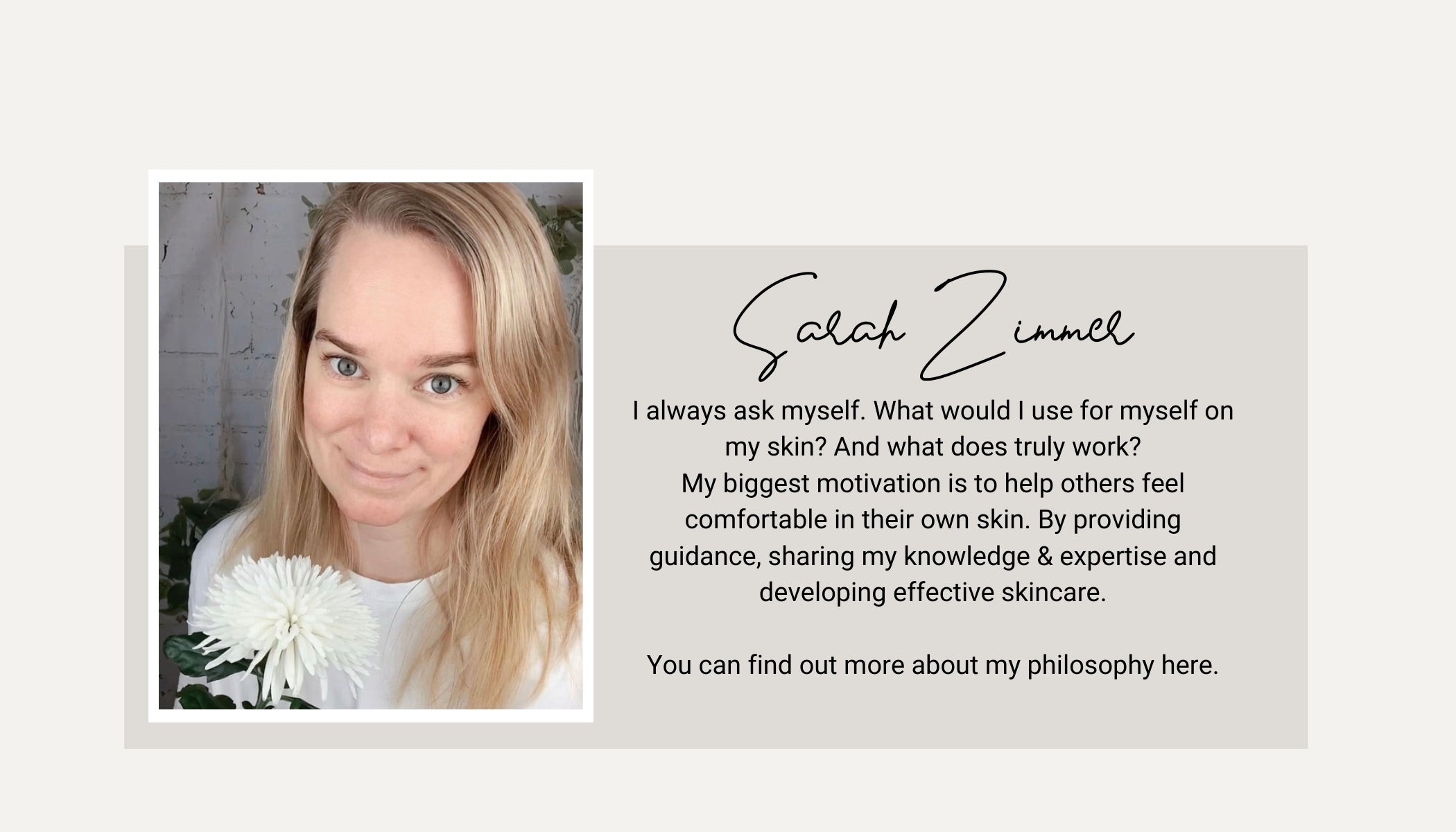Hyaluronic Acid explained: From High to low molecular weight hyaluronic acid and what it Does for Your Skin
Why Hyaluronic Acid Deserves a Spot in Your Daily Skincare Ritual Skincare?
A radiant, well-hydrated complexion is the hallmark of healthy skin — and Hyaluronic Acid plays a vital role in achieving just that. At NAYA, we’ve long embraced its powerful skin benefits: from boosting hydration and plumpness to supporting collagen production and promoting a soft, dewy glow. That’s why we pioneered and you'll find a multi-hyaluronic acid complex in many of our formulations.
But what exactly is hyaluronic acid, how does it benefit our skin, and can it truly deliver on its well-aging promise? Ready to dive deep into the world of skincare with hyaluronic acid? Let’s get started!
What we will be touching on in this article:
- What is Hyaluronic Acid
- How Hyaluronic Acid works
- Why size matters
- Most effective Hyaluronic Acid
- Hyaluronic Acid & Medicine
- The best way to use a Hyaluronic Acid serum
- NAYA: Our formulations
What is Hyaluronic Acid
Hyaluronic acid, also known as hyaluron or hyaluronan, is a polysaccharide—a type of complex sugar. The name originates from the ancient Greek word hyalos, meaning "glass" or "glassy," a reference to its presence in the vitreous body of the human eye.
But that’s not the only place where it’s found in our body. Hyaluronic acid also plays a role in our skin, tendons, ligaments, connective tissues, and joints, where it acts as a natural lubricant. As a substance naturally occuring by the body, it is highly biocompatible and well-tolerated.
Hyaluronic is a complex ingredient that comes in different forms and sizes. Throughout this article, we’ll explain the types, sizes, and uses of hyaluronic acid — and how to choose the most effective formulation for your skin.
The different Types of Hyaluronic Acid
Hyaluronic acid is naturally occuring in our body and has a molecular weight of 4000 to 8,000,000 daltons. You may have seen claims about products containing “millions” of HA molecules. In truth, this refers to molecular weight, not quantity. Understanding the size — not just the presence — of hyaluronic acid is key to getting real results.
In cosmetics, there are different types of hyaluronic acid that can be used in cosmetic formulations. And they vary based on their molecular size and their effects can vary based on the molecular size that is indicated by its daltons. Hyaluronic is typically labelled as sodium hyaluronate (INCI = Sodium Hyaluronate) and thus doesn’t outline the different molecular sizes that a manufacturer is using. It is at the discretion of the brand to be transparent about the type and size of sodium hyaluronate it is using. Again, type in relation to the molecular size which has different effects on the skin. If you want to find out which Hyaluronic Acid a brand is using you need to ask the brand about the specifics so you get the result you are looking for.
Did You Know? Hyaluronic acid isn’t an exfoliating acid like glycolic or lactic — it’s a sugar molecule that acts like a moisture magnet!
What makes Hyaluronic Acid so special
Let's look at the reasons why Hyaluronic Acid is a must in your everyday. Once it sinks into the skin, hyaluronic acid can hold up to 1,000 times its weight in water — and in doing so gives skin a soft, plumper texture and more even skin tone. It can improve fine lines and wrinkles as well.
A higher concentration of hyaluronic acid supports the growth and mobility of fibroblasts—cells responsible for producing collagen and elastin. This process enhances the skin's firmness and elasticity.
Additionally, hyaluronic acid protects fibroblasts by neutralising free radicals, helping to prevent premature skin aging.
In summary, hyaluronic acid:
- Retains moisture, making the skin appear plumper and smoothing out fine lines.
- Stimulates collagen and elastin production, improving skin elasticity and resilience.
- Acts as an antioxidant, shielding the skin from oxidative stress and free radical damage.
Why size matters
But not all hyaluronic acid molecules are created equal. In fact, there are six different sizes. Different molecular weights ability to penetrate to different levels of the skin. Molecules with lower molecular weight are smaller, and can therefore reach the deeper layers of skin. There, they sustain skin’s moisture content. Those with high molecular weights, on the other hand, remain closer to the surface, where they can deliver the most visible results with a shorter life-span. As the results will be washed away with the next cleansing ritual.
Roughly, we distinguish between 2 molecular sizes: high molecular weight hyaluronic acid and low molecular weight hyaluronic acid. However, there are more specific ones that you can see below outlined in the table.
Once it sinks into the skin, hyaluronic acid can hold up to 1,000 times its weight in water — and in doing so gives skin a soft, plumper texture and more even skin tone. It can improve fine lines and wrinkles as well. On top of that, hyaluronic acid is gentle on the skin barrier, making it a good choice whether you have dry or dehydrated skin.
Below is a table to outline the different molecular sizes Sodium Hyaluronate can represent and its effect:
| Type of Hyaluronic Acid |
Molecular Weight in Daltons |
Use / Effect |
|
High Molecular Weight (HMW-HA) |
>1.800.00 |
|
|
Middle Molecular Weight |
1.000.000 to 1.800.000 |
|
|
Low Molecular Weight (LMW-HA) |
400.000 to 1.000.000 |
|
|
S |
100.000 to 400.000 |
|
|
XS |
<100.000 |
|
Most effective Hyaluronic Acid
High molecular weight
High molecular weight hyaluronic acid is the much larger variant as per outlined in the table above. It consists of molecules of 1,500 kD and larger and don't have the ability to penetrate the skin barrier. However, it forms a film with the keratin of the skin on evaporation, which moisturizes the skin and improves its elasticity. Unfortunately, this film is washed off relatively quickly, so that no real long-term effect occurs. Finally, this type has anti-inflammatory properties. So it is quite nurturing and soothing.
Low molecular weight hyaluronic acid
Small but powerful! Low molecular weight hyaluronic acid acts as a hydration powerhouse, deeply moisturizing the skin from within. Low molecular weight hyaluronic acid makes it possible to enter the skin. It consists of molecules of 50 kD and smaller and ensures that water is stored in the connective tissue of the skin. The additional moisture not only makes the skin appear more firmer and more elastic, but also visibly reduces wrinkles. On top of that, with regular use, hyaluronic acid stimulates skin cells to boost their own natural production of the substance. When using low molecular weight hyaluronic acid, the moisture is stored in the skin sustainably. Therefore, it has more advantages and above all a more lasting effect.
Thanks to these properties, low molecular weight hyaluronic acid has even earned a spot on the Society for Dermopharmacy's (GD) list of "Dermocosmetics for Skin Aging." This recognition solidifies its status as an officially acknowledged anti-aging ingredient, making skincare with hyaluronic acid a proven ally against premature aging. And hence we love Hyaluronic Acid at NAYA.
Middle Molecular weight
This form of hyaluronic acid features a slightly larger molecular size, preventing it from penetrating deep into the skin. Instead, it primarily works within the upper layers of the epidermis. Here, it excels at enhancing the skin’s moisture retention, which plumps the surface, refines skin texture, and reduces the appearance of fine lines and wrinkles.
While its effects are more surface-level compared to its low-molecular counterpart, mid-chain hyaluronic acid plays a crucial role in maintaining the skin’s immediate hydration levels. By reinforcing the skin’s moisture barrier, it creates a smoother, more supple appearance and enhances the overall look of radiance. This type of hyaluronic acid is often used in combination with other molecular weights to provide a comprehensive hydration boost and to target multiple layers of the skin effectively.
To Summarize:
- Low Molecular Weight Hyaluronic Acid hydrates deeply, providing internal elasticity.
- Medium Molecular Weight Hyaluronic Acid enhances moisture retention in the top skin layers, refining skin texture and smoothing wrinkles.
- High Molecular Weight Hyaluronic Acid forms a moisture-retaining barrier, protecting the skin’s surface from dehydration and external aggressors.
Clinical studies
Recent independent research have outlined that the hyaluronic you want to use should be between 80,000 to 1,000,000 daltons (80 – 1,000 kDa). See reference to refer to the research. Thus, this seems to be the most effective molecular size that supports the skin to maintain its moisture and elasticity according to studies. Anything higher won’t do much good and has a short-lived effect that is getting removed after you cleanse your face. Anything lower might cause inflammation if used in too high dose as it has the ability to penetrate deep into your skin. So one needs to carefully formulated with those and leave it to experts with years of experience.
Hyaluronic Acid & Medicine
In medicine, e.g. hyaluronic acid is used as joint injection for lubrication and padding of joints. In many eye drops, it is included as a wetting agent for contact lenses or for the treatment of dry, irritated eyes. In aesthetic surgery, it is also used as a skin filler to make wrinkles disappear for a few months.
Hyaluronic acid is certainly an ingredient that is popular in premium products that focus on more mature skin. However, it is never to late to start using hyaluronic acid, a naturally occuring active in our body.
In general, formulations do not include more than 2% and is indicated by manufacturer to ensure safe usage. This indication is based on testing efficacy and safety assessments conducted by independent parties.
Hyaluronic Acid and Skin Aging
As we age, the amount of hyaluronic acid in our skin decreases, leading to a reduction in the benefits mentioned above. The diminished ability to retain moisture leads to dry skin, sinking of the top skin layers, and the loss of elasticity and firmness, which results in fine lines and wrinkles.
Additionally, without enough hyaluronic acid, collagen production and storage are also hindered, which is crucial for firm skin.
So, as hyaluronic acid levels in the skin drop, we experience:
- Reduced moisture retention
- Dryness and dehydration
- Loss of skin volume and firmness
- The formation of wrinkles and fine lines
Therefore, the goal of skincare with hyaluronic acid is to restore its levels to those found in youthful skin. Discover our hyaluronic acid collection.
Pro Tip: Apply your serum while your skin is still slightly damp to enhance absorption and hydration retention.
The best way to use a hyaluronic acid serum
Though hyaluronic acid can attract and retain moisture, it doesn’t necessarily keep that moisture from evaporating over time. That’s why it’s important to maximise the benefits by adding an occlusive or emollient ingredient into your routine, like a face oil or moisturiser.
These help lock in the water that hyaluronic acid attracts, preventing moisture loss and enhancing skin suppleness. For best results, apply hyaluronic acid on slightly damp skin, then follow with an oil or cream to seal in hydration.
To offset this inevitable moisture loss — and therefore minimise dryness, lines and wrinkles, and other signs of ageing — it is important to incorporate it into your daily routine to ensure you can reap all of the benefits.
The NAYA Hyaluronic Essence Serum: A Blend of Five Types of Hyaluronic Acids
A blend of all five types of hyaluronic acid in skincare combines the immediate effects of high-,medium- and low-molecular hyaluronic acid as well as cross- and plant-based hyaluronic acid with the long-term benefits of low-molecular hyaluron. Our Aura Hyaluronic Essence Serum contains these three types of vegan hyaluronic acid, formulated with top-tier biotechnology.
This ensures that your skin is not only hydrated but also protected from moisture loss, plumped from within to reduce fine lines and wrinkles, and defends against premature aging. It’s a highly effective slow-aging formulation.
DID YOU KNOW? At NAYA, we’ve created a multi-molecular hyaluronic acid complex that works across all skin layers — for hydration that lasts and glow that shows. Explore our collection and experience hydration, the NAYA way.
Plant-Based Hyaluronic Acid Alternative from the Silver Ear Mushroom
Our bio-hyaluronic serum also contains extract from the Silver Ear Mushroom (Tremella fuciformis), a plant-based alternative to hyaluronic acid. This mushroom is widely used in Japan and China for its medicinal properties. It contains polysaccharides that form a film on the skin’s surface, enhancing water retention and keeping skin hydrated. Additionally, Tremella extract is a powerful antioxidant that protects against free radicals.
How to Use NAYA’s Aura Hyaluronic Essence Serum
This serum can be used anytime your skin needs a hydration boost. Apply it in the morning under your serum, facial oil or face cream to ensure hydration throughout the day. First, cleanse your face with water, then gently massage 4-5 drops into your skin as needed. Or in the evening to rehydrate your skin from a day out.
Conclusion: Yes to Skincare with Hyaluronic Acid
We can now confidently answer our initial question: Can hyaluronic acid live up to its slow-aging promise? Absolutely. Its ability to bind large amounts of water helps deeply hydrate the skin, making it appear fuller and more youthful. By stimulating collagen production, it improves skin texture and reduces the appearance of fine lines and wrinkles. Plus, it protects against harmful environmental factors, helping to slow the skin aging process.
NAYA's Unique formulation protocol
At NAYA, we stick to those guidelines to formulate effective and safe products. So turn the label around and look where you can read the name Sodium Hyaluronate. Some brands typically use a combination of high molecular weight as it demonstrates an immediate effect to convince the buyer of its effectiveness. However, the effectiveness isn’t long lasting if you want to support your skin in the long run, you need to opt for the middle and low molecular hyaluronic acid. At Naya, we use a low molecular weight to give you lasting effect.
In addition, we are use a newly researched Hyaluronic Acid which is considered an innovation in the cosmetic industry.
You want to learn more about Hyaluronic Acid. Check out the following articles:











Leave a comment